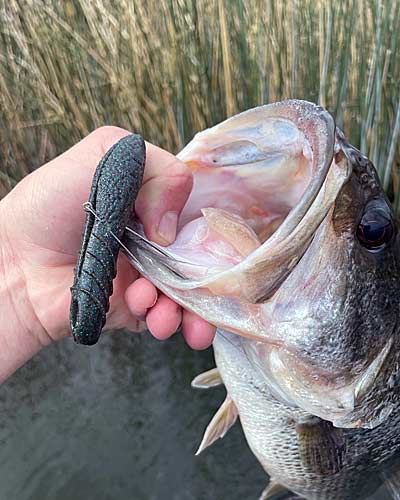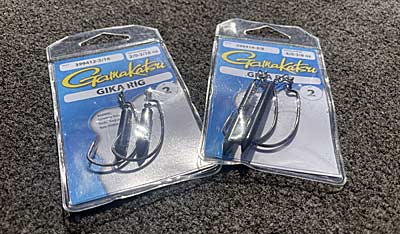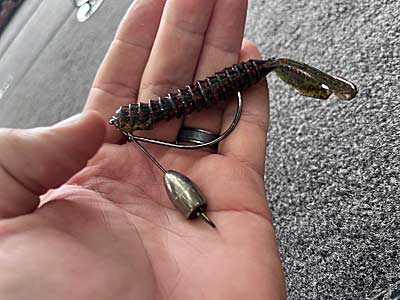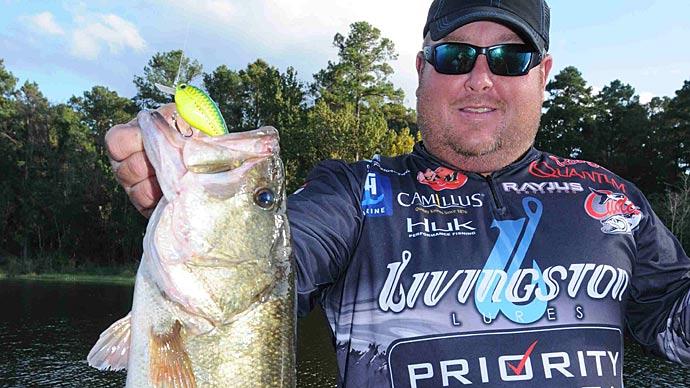Bass fishing is interesting because there are trends that pop up, seemingly overnight, that everyone suddenly seems to be using to catch fish. Then you have lures that have been around for decades that still produce. It's part of the fun of fishing; there are always new ways to fool our favorite fish and add to our existing bag of tricks.
The following five new bass fishing techniques and rigs are under the radar, but those in the know are using them with great success.
-
The Free Rig
Image
The Free Rig is slowly gaining steam here in North America. This technique has gained popularity in the United States after being imported from Japan. It's a cross between a Carolina and Texas rig, where the weight can slide up and down the line through a hole near the top of the weight.
There are weights designed specifically for fishing this way, but a simple bass casting sinker fits the bill as the looped wire at the top is perfect for inserting your line and then tying on your hook.
One key when fishing these baits is to let them fall on a slack line; this allows the bait more freedom of movement, and the lure's spiraling action triggers bites. The weight will hit the bottom first, and your bait will fall slower and unpredictably toward the bottom, generating bites.
You can use any bait, but bulkier creature baits, and worms have a more pronounced falling action on the free rig. Also, using buoyant plastics like Z-Man's ElazTech formula is also great because of the slower fall, leading to even more bites. When at rest, these plastics will rise slowly if the hook isn't too big, giving the fish another chance to eat the bait.
-
"Hover Strolling"
Image
The Core Tackle Hover Rig keeps your bait secure and is perfect for "hover strolling," and can keep you from going through as many plastics and nail weights. Yet another Japanese import, hover-strolling as it is often called, is more of a way to rig a soft plastic baitfish imitator like a soft jerkbait. It excels for suspended bass and works exceptionally well when watching fish on your electronics, primarily forward-facing sonar as you watch fish in front of your boat. You can rig up with a few items or buy jigheads designed for the technique.
Rigging for hover strolling is unique as you insert your hook down further than you would with a standard Texas Rig and use a hook with a 90-degree line tie, such as those used for pouring jigheads. This allows the bait to be horizontal when working through the water column.
The final component is a small nail weight inserted into the soft plastic's head, right where the hook's line tie comes out. You can fish the rig at any depth, and the appearance is unique, a baitfish imitating plastic slowly coming through the water column just like it is swimming.
If you'd rather buy a ready-to-go rig, you're in luck, as companies like Core Tackle have designed a jighead that works for the technique. It has the weight placed perfectly for a horizontal presentation and will keep your bait from tearing up as quickly and save your weights as they will tend to fly off during a cast.
Image
Baits like the Deps Cover Scat are strange looking, but they work. -
Small Dense Plastic Baits
There's no other way to say it, but a handful of new lures look like feces. Popularized in Japan with baits like the Deps Cover Scat and Fish Arrow Heavy Poop, these little baits have now taken hold in America. Yamamoto also recently released their version, called the Yamatanuki. These baits are no joke; they work well.
They look like nothing a bass would eat, but the natural action and profile appeal to bass here in America. They can be fished in many areas and do best when rigged without a weight. However, the dense plastic has more than enough weight to make long casts, even on baitcast gear and heavier lines.
When fishing them, one key is the fall. Cast and let the bait fall on a semi-slack line, like you would a soft stickbait, and let the bait do its thing. The limited action and unintimidating profile do all the work, and many bites will occur as the bait falls. Also, when pitching to shallow cover, the heavily weighed tail section will allow the bait to glide backward, giving the fish a different look as the bait flows into the cover to where they hide.
-
Jika or Gika Rig
Image
Specialty hooks are available for fishing the rig, or you can make your own with a weight and split ring. This one has been around but has yet to reach the mainstream for many anglers. It's a Texas-rigged soft plastic, but the weight is attached to the eye of the hook with a split ring. This gives the bait a different fall and keeps the package nice and compact.
The sky is the limit for the baits you can use as it's generally a standard extra wide gap hook for the rig, and you can use any of your favorite soft plastics. Craws, creatures, and beaver-style baits do well because this rig excels for flipping, pitching, and casting to shallow water targets.
Image
The Tokyo Rig gives your soft plastic baits a new look; you can fish it just about anywhere. -
Tokyo Rig
Similar to the Jika Rig, the Tokyo Rig is a compact package that allows you to fish a Texas-rigged soft plastic. The rig is also like a drop-shot, with the weight at the bottom and the bait above. This gives the bait a vertical presentation up off the bottom and closer to the fish.
This rig can be fished in many ways, and many anglers are finding success flipping and pitching it around shallow grass and cover, but with the added benefit of the look of a drop-shot with beefier tackle. It's also perfect for fishing swimbaits and creature baits, fishing it by reeling it slowly along the bottom. Again, it keeps the bait a few inches off the bottom and gives the fish a different look.
There are always new ways to catch a bass. Some are trends that will come quickly before fading away, and some are destined to stick around. So giving them a fair shot is always a good idea, as you might find the next big thing.




